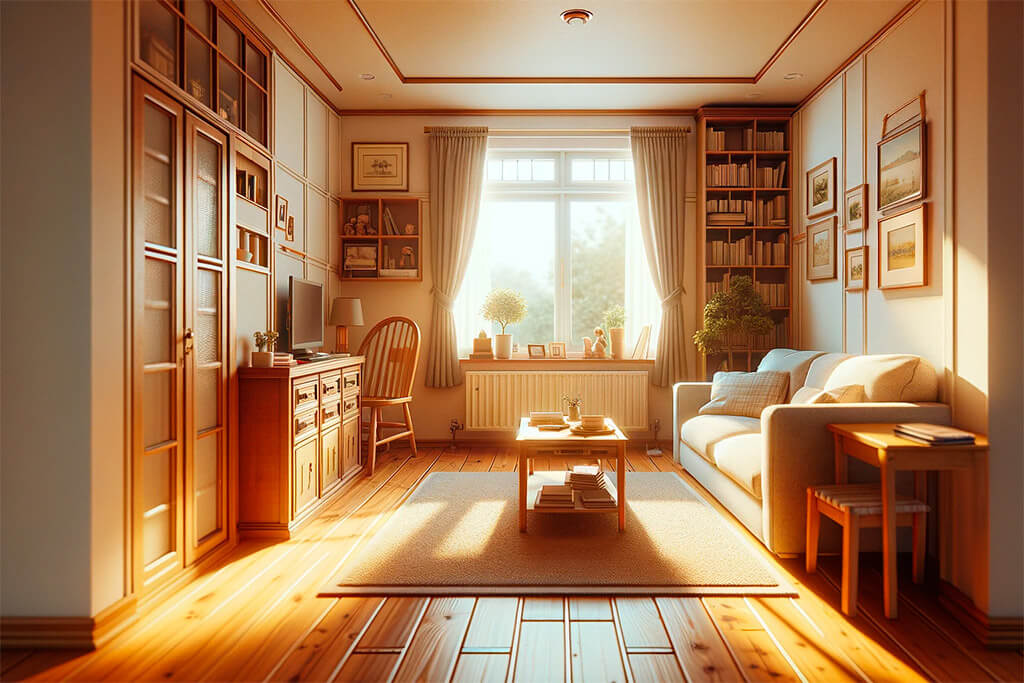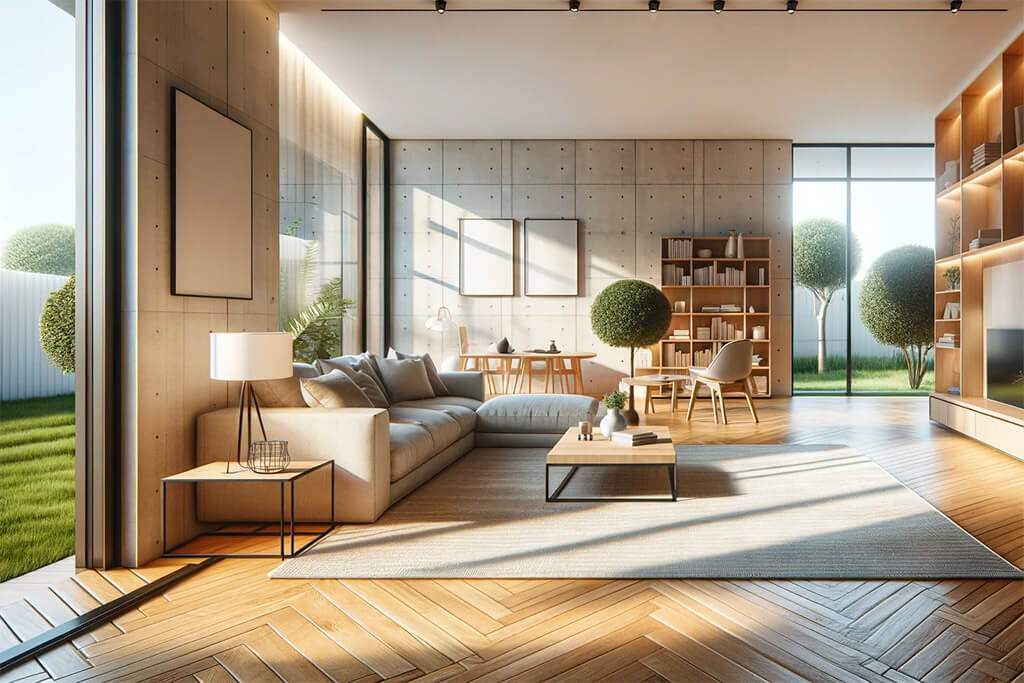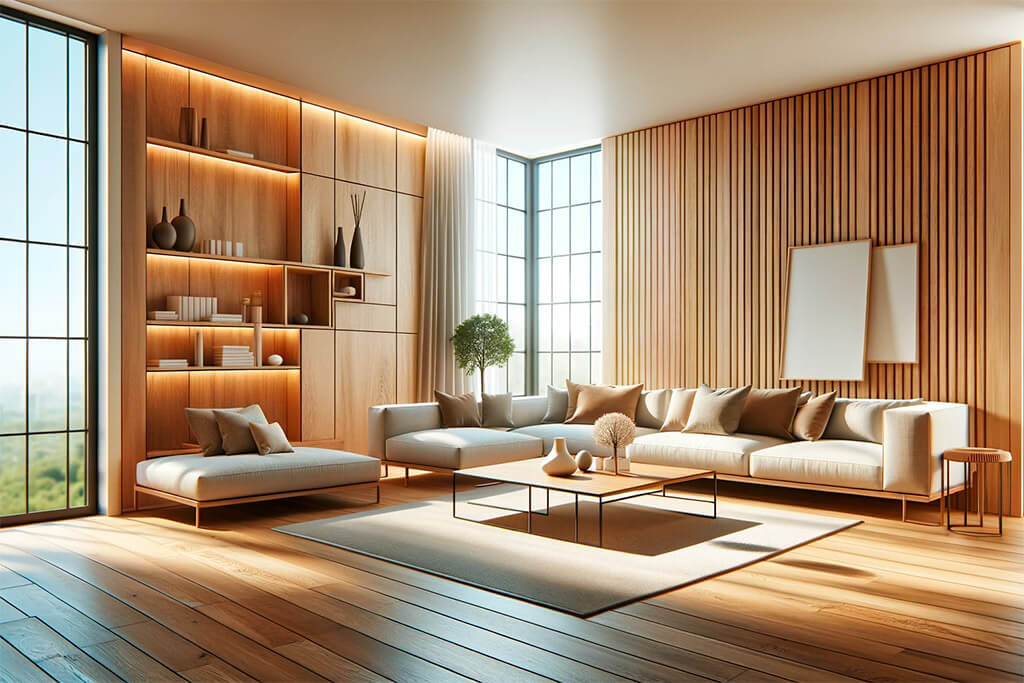When it comes to enhancing your living room with wood flooring, the decision is not just about aesthetics, it’s about choosing a long-lasting, functional feature for your home. Wood floors have stood the test of time in both durability and style, making them a top choice for homeowners.

The Popularity and Benefits of Wood Flooring in Living Rooms
Wood flooring is not just another home trend, it’s a timeless choice that brings a unique blend of beauty and practicality to any living space. Its enduring popularity lies in its ability to add character and warmth to a room, while also being robust enough to handle daily wear and tear. Moreover, wood floors are known for their ability to stand the test of time, offering an enduring appeal that many other flooring options lack.
The Article’s Aim
This article is designed to be a comprehensive guide for anyone considering wood floors for their living room. It aims to provide a balance of creative ideas and actionable advice, ensuring that whether you’re a seasoned craftsman or a DIY beginner, you have the information needed to make informed decisions about your flooring project.
The Appeal of Wood Floors in Living Rooms
Aesthetic Appeal:
- Versatility: Wood floors offer unmatched versatility in design. Whether your living room has a contemporary or a classic look, there’s a wood flooring style that can complement it perfectly.
- Elegance and Warmth: The natural elegance of wood flooring is unparalleled. It brings a sense of warmth and coziness to any living room, making it more inviting.
Environmental Benefits and Durability:
- Opting for wood flooring is a nod to environmental sustainability, especially when sourced from responsibly managed forests.
- The durability of wood floors is remarkable. With proper care, they can last for generations, making them a wise investment for any homeowner.
Value Addition to Your Home:
Wood floors are not just about aesthetics, they are also a smart financial decision. They can significantly increase the value of your home, often being a key selling point in the real estate market.

Choosing the Right Wood Floor for Your Living Room
Types of Wood Floors:
The choice of wood type – oak, maple, cherry, and others – plays a crucial role in the overall look and durability of your flooring.
Wood Grain, Color, and Plank Width:
- The grain pattern, color, and plank width are critical factors that can dramatically alter the appearance of your living room. Each element should be chosen carefully to achieve the desired effect.
Matching Floors with Living Room Style:
The style of your living room should guide your choice of wood flooring. The goal is to create a harmonious and cohesive look that enhances the overall design of your space.
Light vs. Dark Wood:
The choice between light and dark wood floors can significantly impact the ambiance of your living room. Light woods tend to make a space feel more open, while dark woods create a sense of richness and depth.

Installation Insights
DIY vs. Professional Installation:
Deciding between DIY and professional installation depends on your skill level and the complexity of the project. Both options have their merits, and the choice should align with your comfort and experience.
Essential Steps for Installing a Wood Floor:
- A successful installation starts with thorough preparation. This includes ensuring a clean, level subfloor and precise measurements.
Tips for Preparing the Living Room:
Before installation, it’s crucial to clear the room completely and check the condition of the subfloor. Any irregularities can affect the final result.
In the following sections, we’ll delve deeper into each aspect, offering detailed instructions and insider tips to help you navigate the process of choosing and installing wood flooring in your living room. This guide is designed to provide you with the knowledge and confidence to transform your living room into a beautiful and functional space that stands the test of time.
Maintenance and Care
Maintaining a wood floor in your living room isn’t just about keeping it looking good, it’s about preserving its life and functionality. Think of it as regular upkeep for a valuable piece of your home.
Routine Cleaning and Maintenance Tips
- Daily Dusting: Just like brushing off debris from your workbench, use a soft broom or microfiber mop to keep the dust at bay.
- Weekly Mopping: A slightly damp mop does the trick. It’s similar to applying a thin coat of paint, too much water can be detrimental.
- Spill Management: Address spills immediately to prevent water damage, akin to quickly patching up a leak.
Preventing Scratches and Damage
- Furniture Pads: Like cushioning heavy equipment, use felt pads under furniture legs to prevent scratches.
- Rugs in High-Traffic Areas: Lay rugs where foot traffic is heaviest, providing a buffer like putting down protective sheets during a messy job.
- Regular Checkups: Regularly inspect for wear and tear, much like you would with your tools or equipment.
Long-Term Care and Refinishing
- Refinishing: Consider sanding and refinishing your floors every few years, akin to repainting and maintaining a well-used space.
- Deep Clean: Occasionally, a professional deep clean can rejuvenate your wood floors, similar to a comprehensive service of a piece of machinery.
Design Ideas for Living Rooms with Wood Floors
Choosing Furniture and Decor
- Complementary Styles: Select furniture that echoes the wood’s character. It’s like choosing the right fixtures to complement the structural design of a house.
- Avoid Scratching: Opt for furniture with wider bases to distribute weight, much like how load distribution is considered in building.
Colour Scheme Suggestions
- Light Wood Floors: These work well with darker furniture for contrast, creating a visual balance like a well-planned lighting scheme in a room.
- Dark Wood Floors: Lighter tones in furniture and walls balance the richness, similar to using lighter materials to offset heavier structural elements.
Floor Decoration Ideas
- Rugs: Use them to define spaces and add color, like how landscaping enhances a building’s exterior.
- Natural Elements: Incorporate plants or stone to complement the wood’s natural essence, like adding natural elements to soften a built environment.
FAQ Section
Hardwoods like oak, maple, or cherry are ideal. They’re the dependable framework of wood flooring, balancing beauty with resilience.
Implement felt pads and rugs, and avoid dragging furniture, much like using safeguards in a construction zone.
It’s feasible, provided the existing floor is stable and level, similar to ensuring a solid foundation before building.
Match the wood tone with room size and lighting. Lighter floors for smaller, darker rooms, and vice versa, akin to choosing the right color palette for a room’s size and lighting.
Choose harder woods with robust finishes, similar to selecting durable materials for high-traffic areas in construction.
